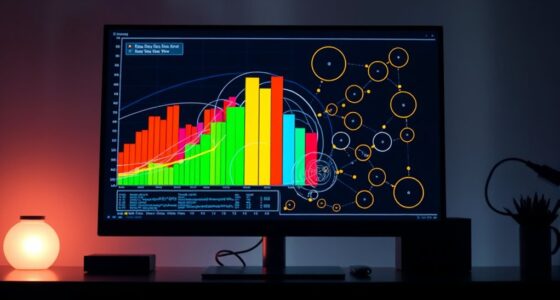ARIMA models help you forecast time series data by identifying patterns, making data stationary through differencing, and selecting appropriate parameters like p, d, and q. You estimate these parameters using methods like maximum likelihood, then check residuals to guarantee they behave like white noise. Proper diagnostics prevent overfitting or underfitting, leading to reliable predictions. Continuing further, you’ll find detailed steps to apply and refine ARIMA models effectively.
Key Takeaways
- ARIMA models combine autoregression, differencing, and moving averages to analyze and forecast time-series data effectively.
- Ensuring data stationarity through differencing is crucial for accurate ARIMA modeling.
- Proper parameter selection (p, d, q) is guided by autocorrelation and partial autocorrelation plots.
- Residual diagnostics, like the Ljung-Box test, confirm the model’s adequacy and help prevent overfitting.
- A well-fitted ARIMA model enables reliable forecasting by capturing underlying data patterns accurately.

Have you ever wondered how to accurately forecast future data points based on historical trends? When working with time-series data, understanding and applying ARIMA models can seem intimidating at first, but breaking down the process makes it manageable. The key to reliable forecasts lies in proper model diagnostics and precise parameter estimation. These steps ensure your ARIMA model reflects the underlying data patterns accurately and can produce dependable predictions.
To start, you need to identify whether your data is stationary—that is, its statistical properties like mean and variance remain constant over time. If your data isn’t stationary, you’ll have to transform it, often through differencing. Once your data is ready, you select the order of the ARIMA model, which includes the autoregressive order (p), the degree of differencing (d), and the moving average order (q). This involves examining autocorrelation and partial autocorrelation plots, helping you decide the initial parameters. But selecting these parameters isn’t enough; you need to estimate them accurately through techniques like maximum likelihood estimation. This step fine-tunes your model, making it fit your data as closely as possible.
Parameter estimation is essential because it directly influences the model’s forecasting power. Once you’ve estimated the parameters, it’s essential to run model diagnostics. Model diagnostics involve checking residuals—the differences between observed and predicted values—to ensure they resemble white noise, meaning no patterns are left unexplained. If residuals display autocorrelation or non-constant variance, your model needs adjustment. You might revisit the parameter estimates, try different orders, or incorporate additional data transformations. Performing formal tests, like the Ljung-Box test, helps confirm whether residuals are truly uncorrelated. Additionally, understanding the importance of model fit quality ensures your model accurately captures the data’s underlying structure, which is crucial for reliable forecasting.
This iterative process of estimation and diagnostics might seem tedious, but it’s indispensable. Proper diagnostics ensure that your ARIMA model isn’t overfitting or underfitting the data, which can lead to unreliable forecasts. When the residuals pass these tests, you can confidently use your model to project future points. Remember, a well-fitted ARIMA model isn’t just about the initial fit; it’s about ongoing validation through residual analysis and model refinement.
In essence, mastering model diagnostics and parameter estimation transforms a basic ARIMA setup into a powerful forecasting tool. These steps help you capture the true underlying patterns, ensuring your predictions are both accurate and robust. By systematically checking and refining your model, you gain confidence in its ability to forecast future data and make informed decisions based on your time-series analysis.
Frequently Asked Questions
How Do ARIMA Models Compare to Machine Learning Approaches?
You find that ARIMA models focus on linear, statistically driven patterns, making them straightforward for time-series data. In contrast, machine learning approaches like neural networks and ensemble methods can capture complex, nonlinear relationships but require more data and tuning. While ARIMA is easier to interpret, machine learning offers higher flexibility and potentially better accuracy for intricate patterns, especially when combined with neural networks or ensemble techniques.
Can ARIMA Handle Multivariate Time Series Data Effectively?
You might find ARIMA models struggle with multivariate challenges because they are primarily designed for univariate data. When faced with data complexity involving multiple variables, ARIMA’s effectiveness diminishes, as it can’t easily capture interactions between variables. While extensions like VAR exist, they often require more complex modeling and assumptions. So, for multivariate data, you’ll probably want to explore other methods better suited to handle data complexity.
What Are Common Pitfalls When Selecting ARIMA Model Parameters?
Imagine tuning a musical instrument—you want the perfect pitch without distortion. When selecting ARIMA model parameters, you risk overfitting if you’re too fine-tuned or miss the mark with overly simple settings. Parameter sensitivity can lead to unstable forecasts, like a guitar string that’s too tight or loose. Be cautious, test thoroughly, and avoid these pitfalls to guarantee your model hits the right note without risking overfitting or instability.
How Do ARIMA Models Perform With Non-Stationary Data?
When working with non-stationary data, ARIMA models may struggle due to stationarity challenges, causing inaccurate forecasts. You can address this by applying differencing techniques to stabilize the mean and variance. This transforms the data into a stationary series, improving model performance. However, over-differencing can lead to loss of information. Always check for stationarity after differencing, and fine-tune parameters to guarantee reliable predictions.
Are ARIMA Models Suitable for Real-Time Forecasting Applications?
Imagine trying to catch a train before it leaves—quick, precise timing matters. ARIMA models excel in real-time forecasting because of their computational efficiency, allowing rapid updates. With seasonal adjustments, they adapt to periodic patterns, making them suitable for dynamic environments. While they may not handle sudden shocks perfectly, they’re a solid choice when quick, accurate forecasts are needed, like predicting stock prices or sales trends on the fly.
Conclusion
Now that you’ve uncovered the secrets of ARIMA time-series models, you’re equipped to forecast with confidence like a supercharged data wizard. Remember, mastering ARIMA isn’t just useful—it’s the key to transforming raw data into crystal-clear insights that can outsmart even the most complex patterns. With your newfound knowledge, you’re unstoppable, capable of tackling any time-series challenge that comes your way. Get ready to make predictions so precise, they might just seem magical!










